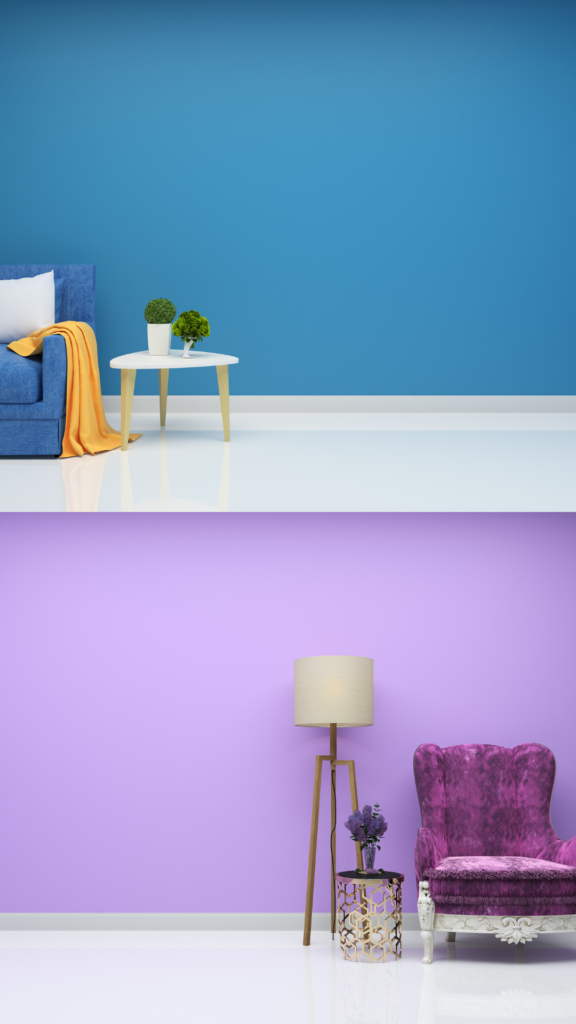Harnessing the Power of Color Psychology in Interior Design
In the world of interior design, color is far more than just a visual element. It serves as a powerful tool to set the mood, evoke emotions, and create the desired atmosphere in a space. Color psychology in interior design, the study of how colors affect human feelings and behaviors, has become an essential consideration in designing interiors that feel cohesive and comfortable. From energizing hues to calming tones, here’s how different colors can impact a room and how they can be best used in interior design.
The Influence of Color in Interior Spaces
The Psychology of Popular Colors in Interior Design
1. Red: Bold and Stimulating
- Psychological Effect: Red is one of the most stimulating colors. It can evoke feelings of passion, excitement, and warmth. Color psychology in interior design shows that red can increase heart rates and energy levels, making it an intense and lively choice.
- Ideal Spaces: Red works well in dining rooms and kitchens, where it can stimulate appetite and conversation. It can also create a cozy feel in living rooms. However, red should be used sparingly in bedrooms, as it can be too energizing for restful spaces.
2. Orange: Vibrant and Friendly
- Psychological Effect: Orange is associated with creativity, energy, and warmth. It has an inviting and friendly feel, often making spaces feel vibrant and cheerful.
- Ideal Spaces: Color psychology in interior design suggests orange is ideal for areas where socialization or physical activity occurs, such as playrooms, workout spaces, or even entryways where a welcoming feel is desirable. However, it’s generally too lively for spaces meant for relaxation, like bedrooms or calm living areas.

3. Yellow: Cheerful and Optimistic

- Psychological Effect: Yellow is often linked to happiness, optimism, and mental clarity. It can make spaces feel sunny and bright, creating a sense of openness and warmth.
- Ideal Spaces: Yellow works well in kitchens, breakfast nooks, and dining areas where a lively, cheerful atmosphere is welcome. Soft yellows can bring brightness to smaller spaces like bathrooms or hallways. Color psychology in interior design advises moderation with yellow, as too much can feel overwhelming.
4. Green: Restorative and Natural
- Psychological Effect: Green is a color of nature, symbolizing harmony, tranquility, and renewal. It has a calming effect and can make spaces feel balanced and serene.
- Ideal Spaces: Green is perfect for living rooms, bedrooms, and bathrooms where relaxation and rejuvenation are key. Its natural feel makes it ideal for connecting indoor spaces with outdoor landscapes. Soft, muted greens can bring a sense of calm, while darker greens add elegance.
5. Blue: Calm and Focused
- Psychological Effect: Blue is known for its calming and serene qualities, making it one of the most popular colors in interior design. It can help reduce stress and create a sense of tranquility.
- Ideal Spaces: Blue is perfect for bedrooms, bathrooms, and offices, where relaxation or focus is essential. Lighter shades of blue can make a small room feel more open, while darker blues create a sense of sophistication and comfort.
6. Purple: Luxurious and Creative
- Psychological Effect: Purple combines the calmness of blue with the warmth of red, giving it an air of luxury, mystery, and creativity. Darker purples evoke opulence, while lighter shades like lavender have a calming effect.
- Ideal Spaces: Purple works well in bedrooms and creative spaces, where it can inspire originality. Rich purples can bring a touch of elegance to dining rooms or formal living rooms.

Using Color Psychology to Create a Balanced Space

When applying color psychology in interior design, balance is crucial. Overuse of any one color can lead to an overwhelming effect, while a thoughtful blend of colors can make a space feel cohesive. Here are a few tips:
- Start with Neutrals: Using neutrals as a base color allows you to introduce bolder shades as accents without overwhelming the room.
- Use Accent Colors: Accent colors add visual interest and can be used strategically in areas where you want to draw attention, such as statement walls or key furniture pieces.
- Consider Lighting: Natural and artificial lighting play a big role in how colors are perceived. For example, natural light can make colors appear brighter, while artificial lighting can alter their intensity and tone.
- Align with Purpose: The color choice should match the room’s purpose. For instance, a bedroom should ideally have calming tones, while a home office may benefit from colors that improve focus and creativity.
Conclusion
Address List
- Office No.16, 4th Floor, Landmark Commercial Complex, Anand Nagar, Kothrud, Pune-38
- +91 7219350563
- support@imasee.com
Links List
IMASEE
Thoughtful Design For The Way You Live

Eclectic style is the best as it allows you to be experimental and mix parts out of different designs to come up with a personalized space.
Color Palette: Mix, match, and the color palette: one tip is to go with contrasting colors such as emerald green, dark blue, and, or gold.
Furniture: Correlate modern and vintage furniture to get an eclectic feeling. Velvet sofas, one of the kind chairs, and textured rugs woven by hand enable the combination of various styles in a seamless manner.
Decor: Pass on your quirky and original character by showing off artist statements, book collections, and applique bed linens. One of the elements you can use boldly is pattern but neutralize it by popping up the large furniture.
Lighting: Indulge in elegance with beaded chandeliers or even tall, bright floor lights.

